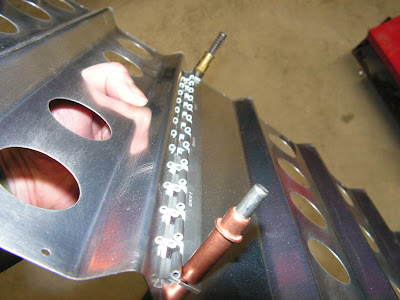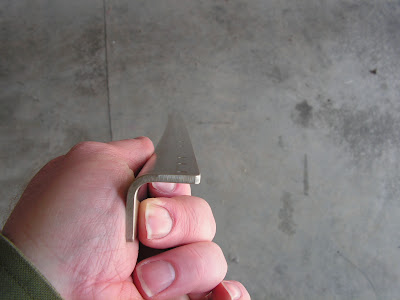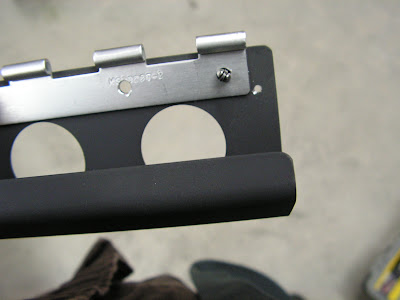Reference: page 26-03, 26-04; 4.0 hours
I'm in the process of building the Seatbacks for the RV-12 aircraft. During this build session thing got a little interesting as I wanted to final paint the Seatbacks before assembling the hinges to them. As such, some of the steps are out of sequence from how they appear in the plans by Van's Aircraft.
One other thing I ran into was the floor mounting hinge on the right seat is off center of the control stick by 1/2". Yes, it is built according to the plans. In fact I called Van's Aircraft and they went out and measured the factory airplane and sure enough their seat is off by 1/2" as well. In addition to this, the carpet kit is cut for the seat bing off center as well. The good new is I've ridden in the right seat of the factory plane and you just don't notice it!
Step 1: Cleco the locating hole of the Fwd Seatback Brace Hinge to the Seatback at the location shown in figure 1 on page 23-03 of the RV-12 plans by Van's Aircraft. Clamp the hinge parallel to the seatback corrugations.
 Builder's note: To ensure this part is set correctly I drew a centering mark on the hinge to align it visibly through the holes.
Builder's note: To ensure this part is set correctly I drew a centering mark on the hinge to align it visibly through the holes.
 Step 2:
Step 2: Match-drill #30 the holes from the Seatback into the Fwd Seatback Brace Hinge. Mark parts, disassemble and deburr, cleco back together.
 NOTE: For Step 3 through Step 7, the rivet orientations are specified in the RV-12 plans.
Step 3:
NOTE: For Step 3 through Step 7, the rivet orientations are specified in the RV-12 plans.
Step 3: Rivet the Aft Seatback Brace using the rivets called out in figure 2 of the RV-12 plans. Set the manufactured heads on the seatback brace.
Builder's note: My Seat side angles had a slight curve to them that needed to be striaghtened out before assembly.
 Step 4:
Step 4: Cleco the Upper, Lower and L&R Seatback Angles to the Seatback as shown in figures 3 & 4 of the RV-12 pans on page 26-03. Final-drill #12 the hole in each lower corner common to the left or right AND the lower seatback angles and seatback. Disassemble and deburr.
 Some of the following steps are out of order because I wanted to paint the parts before riveting on the hinge material. For final finish I am using the two Rust-oleum products show below. After etching, alodining and zinc chromate, I paint the surface the black primer as a color cover coat then spray a light coating of the Texture paint. I used this system on the RV-10 and have been happy with the appearance and the fact it is easily repaired if you get a scratch.
Some of the following steps are out of order because I wanted to paint the parts before riveting on the hinge material. For final finish I am using the two Rust-oleum products show below. After etching, alodining and zinc chromate, I paint the surface the black primer as a color cover coat then spray a light coating of the Texture paint. I used this system on the RV-10 and have been happy with the appearance and the fact it is easily repaired if you get a scratch.
 Step 5:
Step 5: Rivet the Upper Seatback Angle to the top row of holes in the Seatback per call-out in figure 3 of the RV-12 plans. Set the manufactured heads on the seatback. Leave open the first hole at both ends of the upper heads on the seatback.
 Step 6:
Step 6: Rivet the Fwd Seatback Brace Hinge to the Seatback using the rivets called out in figure 3 of the RV-12 airplane plans.Set the manufactured heads on the seat back.
 Step 7:
Step 7: Rivet the Lower Seatback Angle and the Seatback Hinge to the Seatback per call-out in figure 3. Set the manufactured heads on the seatback hinge. Leave open the first hole at both ends of the lower seatback angle.
 Step 8:
Step 8: Rivet the L R Seatback Angles to the Seatback using the rivets called out in figure 4 of Van's Aircrafts plans on page 26-03. Set the manufactured heads on the seatback angles. Hereafter refer to this assembly as the Seatback Assembly.
 This completes page 26-03
This completes page 26-03
 Reference page 26-04 of Van's Aircraft RV-12 plans
Note: The hinge pins that will be used for the steps on this page were set aside on page 26-02, Step 4 and Step 7.
Reference page 26-04 of Van's Aircraft RV-12 plans
Note: The hinge pins that will be used for the steps on this page were set aside on page 26-02, Step 4 and Step 7.
Step 1: Cut a 14 1/2 inch length of hinge pin. Make a one inch long 90 degree bend at one of the ends. File the other end of the hinge pin to make a dull point.
 Step 2:
Step 2: Attach the Seatback Brace to the back of the Seatback Assembly, by inserting the 14 1/2 inch hinge pin through the Fwd and Aft Hinges as shown in figure 1 on page 26-04 of the RV-12 plans.
Step 3: Drill #52 a hole in the Seatback Brace mext to the bend at the end of the hinge pin as shown in figure 1 of Van's Aircraft plans on page 26-04.
 Step 4:
Step 4: Secure the bent end of the hinge pin using safety wire through the #52 hole.
 Step 5:
Step 5: Cut two % 1/2 inch lengths of hinge pin. Make a one inch long 90 degree bend at one end of each pin. File the other end of each hinge pin to make a dull point.
 Step 6:
Step 6: Using the 5 1/2 inch hinge pins, secure the Seatback Assembly to either the forward or aft Seatback Hinge as shown in the RV-12 plans on page 26-02.
This completes the assembly of the RV-12 Seatbacks. As far as the right seat not being centered to the control stick, I'm going to leave it per the RV-12 plans. If it bugs me after getting the LSA certification then I will make new hinge mount and shift the seat to center.
I'm going to leave you with a few pitures of the seats mounts for the RV-12 aircraft.





